
- two Stereo Loudspeakers are positioned each 30 degrees out of axis left and right to create an angle of 60 degrees between each other. The stereo speakers and the preferred listening position (the hot spot) create an equilateral triangle between Speaker L - Speaker R - Listener. The angle of 60 degrees is agreed between many professionals as the optimal listening angle. If spaced farther apart phantom images between the two speakers are not stable anymore.

- two Stereo Loudspeakers are positioned between 30 and 45 degrees out of axis left and right.
- one Center Loudspeaker positioned on axis
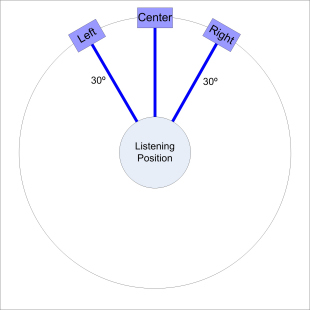 | 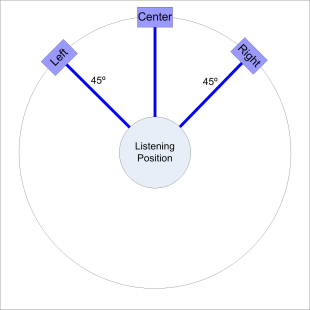 |
Two different approaches are in confrontation:
- 1. For compatibility between two-channel stereo material (all regular CD and other two-channel mixes) and three-channel mixes the agreed angle of 30 degrees each between the left and right speaker should be maintained in a three-channel setup.
- 2. For exclusive three-channel stereo mixes the angle between the left and right speaker could be widened to up to 45 degrees each, achieving a wider stereo image without unstable phantom images between the left and center speaker and between the right and center speaker. As soon as pure two-channel material is played back, problems with phantom images can occur.
All three speakers should be identical in sound dispersion and in the frequency bandwidth. A horizontally mounted center speaker and two vertically mounted left and right speakers are not acceptable for a music playback setup.
For music playback with a five channel and a seven channel setup the ITU-R BS.775-2 recommendations were established (ITU = International Telecommunication Union), all speakers should be identical, no additional subwoofer is used.
 |
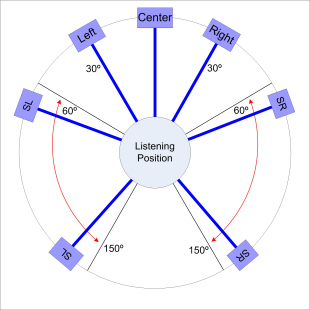 |
| ITU-R BS.775-2 (3/2 Setup) | ITU-R BS.775-2 (3/4 Setup) |
- two Stereo Loudspeakers are positioned each 30 degrees out of axis left and right. These stereo speakers and the preferred listening position (the hot spot) create an equilateral triangle between Speaker L - Speaker R - Listener. The two stereo speakers should not be spaced farther apart to ensure that phantom images between the two speakers are stable (independently of a third center speaker). The stereo speakers are used for all stereophonic content, music etc.
- one Center Loudspeaker on axis, mainly used to fix the image position of dialogue in movies etc. Using only a phantom image between the two stereo speakers for the center dialogue is not providing a stable image perfectly located in the center (on axis), especially if the listener is not 100% positioned in the hot spot. With a separate center speaker it is possible to create a fixed and stable sound image exactly in the center of the movie picture.
- in the 3/2 (five channel) setup two Surround Loudspeakers are positioned between 100 and 120 degrees off axis on both sides
- in the 3/4 (seven channel) setup four Surround Loudspeakers are positioned between 60 and 150 degrees off axis on both sides
The setup with seven channels and a front surround angle of 60 degrees takes in account that the most supporting lateral reflections in concert halls are sidewall reflections between 30 and 90 degrees with a desirable maximum at 60 degrees (found in multiple listening tests).
The ITU Standard is not specifying a separate subwoofer, all five channels' speakers are identical and able to transmit the entire frequency range. The setup with identical speakers for all channels was created mainly for music mixes and not for movies. It must also be emphasized that the two or four surround speakers are not intended to create a full 360 degree sound image.
 |
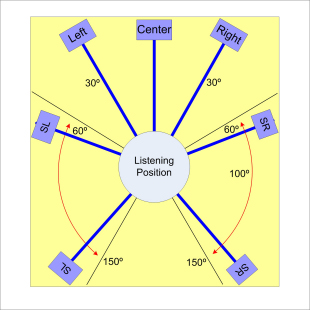 |
| ITU-R BS.775-2 (3/2) in a real rectangular room | ITU-R BS.775-2 (3/4) in a real rectangular room |
| Channel Order | |||||||
| Channel 1 | Channel 2 | Channel 3 | Channel 4 | Channel 5 | Channel 6 | Channel 7 | Channel 8 |
| Front Left | Front Right | Center | Sub / LFE | Surround Left |
Surround Right |
Surround Rear Left |
Surround Rear Right |
| Color Code | |||||||
| white | red | green | purple | blue | grey | brown | khaki |
Soundcard audio outputs are color coded in the following order:
| Soundcard Color Coding, 5.1 | |||||||
| Mic In | Line In Stereo |
Left, Right Out Stereo |
Surround Out 2 channels |
Center, Sub Out 2 channels |
|||
| red/pink | blue | green | black | orange | |||
The suggestion by Dolby Laboratories, Inc. for the 7.1 Dolby Digital Plus speaker setup is the following:
 |
| Dolby Digital Plus Setup |
Because the LFE material is by definition only the low frequency effects material (explosions etc.), the low frequency content of the regular stereo signals should be reproduced by the main stereo loudspeakers. This is a generally so in cinema systems but for home cinema a different approach is used. With a proper bass management system all low frequency content of all channels can be fed into the subwoofer channel. This subwoofer channel is not a LFE channel anymore but a reproduction channel for all low frequency content, it carries the low-frequency content of all five channels plus the LFE content. Because of psychoacoustic reasons the position of the low-frequency content is difficult to localize and the splitting and mixing into one channel will not be recognized. With bass management the low frequency range for the content of the regular five channels must be properly defined (bandwidth, level, crossover frequency).
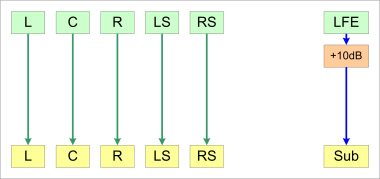 |
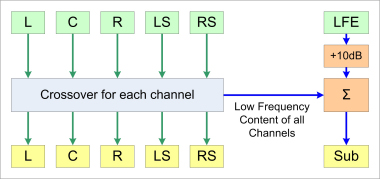 |
LFE channel without bass management | bass management for all channels |
| Left | Right | Center | Left Surround | Right Surround | |
| Left Channel | 1.000 | 0.000 | 0.7071 | 0.7071 | 0.000 |
| Right Channel | 0.000 | 1.000 | 0.7071 | 0.000 | 0.7071 |
| Left | Right | Center | Left Surround | Right Surround | |
| Left Channel | 1.000 | 0.000 | 0.000 | 0.7071 | 0.000 |
| Right Channel | 0.000 | 1.000 | 0.000 | 0.000 | 0.7071 |
| Center Channel | 0.000 | 0.000 | 1.000 | 0.000 | 0.000 |
In a typical home cinema setup compromises have to be made because of the picture source, normally a flat screen. Only using a projection system and a perforated video screen as in professional movie theatres, a 'correct' setup can be maintained. In a regular setup the center speaker must be a horizontally installed unit with different acoustical properties as the L and R speakers. All three front speakers should be time aligned to have the same virtual distance from the listening position.
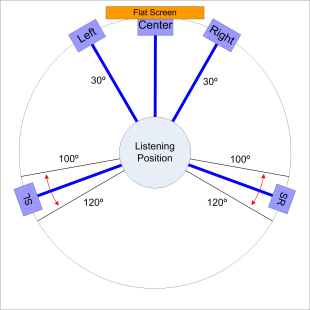
Because of the necessary physical size of the stereo speakers to reproduce adequate levels in the entire frequency range, the center speaker normally cannot have the same size because it would sit just in front of the movie screen. A speaker with a different design mounted horizontally under or above the screen must be used. Such speakers for physical reasons have a different sound dispersion pattern compared to vertically mounted stereo speakers.
Another challenge are the surround speakers for home cinema systems. These are generally much smaller than the center systems. This is in conflict with the ITU standard, but became the norm because of space and budget reasons in regular households. Two or four relatively small surround speakers are able to create an adequate surround sound impression, especially compared to a situation there no large surround systems could be put in position.
THX Ltd was established in 1983 by the George Lucas company with the purpose to create standards to correct inadequate movie playback in cinemas.
" ..is the founder of quality assurance programs for superior cinema presentation.." (from the THX Website)
THX Website: "A THX Certified Cinema is built from the ground up, taking extra steps, often times installing additional materials and equipment, to create an environment that will totally immerse you in the story. Whether you’re on a first date, going for a blockbuster opening night, or catching a matinee, get ready to experience the magic and emotional impact created by the director for you to enjoy."
See THX.